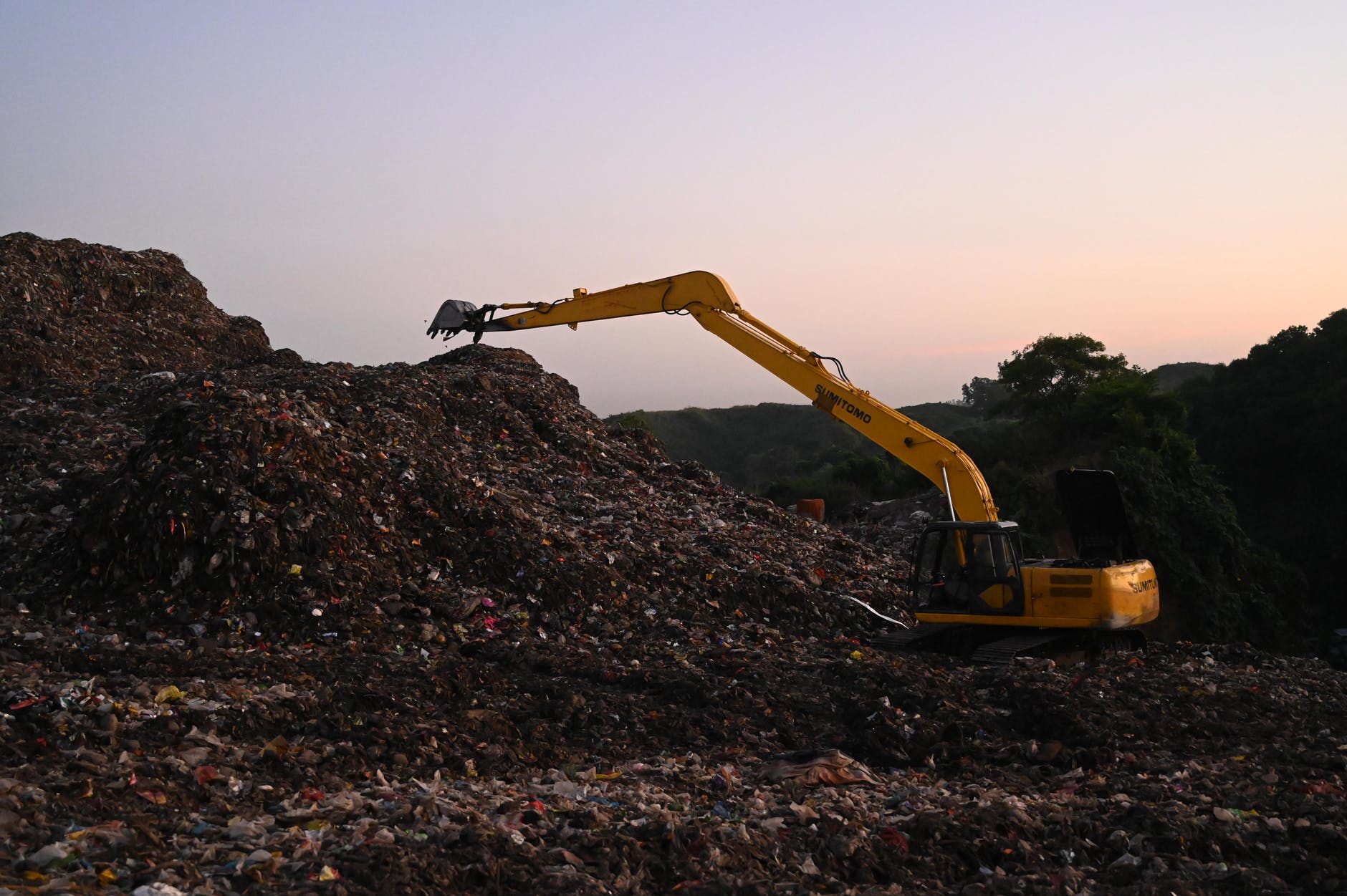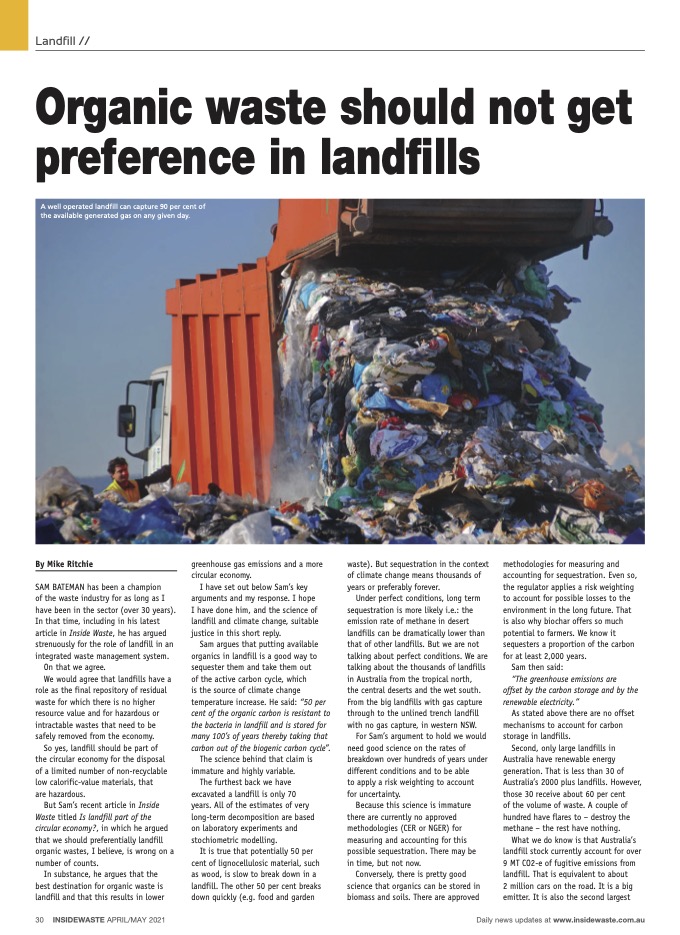Organic waste should not get preference in landfills
By: Mike Ritchie, MRA Consulting Group

Sam Bateman has been a champion of the waste industry for as long as I have been in the sector (over 30 years). In that time, including in his latest article in Inside Waste, he has argued strenuously for the role of landfill in an integrated waste management system.
On that we agree.
We would agree that landfills have a role as the final repository of residual waste for which there is no higher resource value and for hazardous or intractable wastes that need to be safely removed from the economy.
So yes, landfill should be part of the circular economy for the disposal of a limited number of non-recyclable low calorific value materials, that are hazardous.
But Sam’s article in Inside Waste “Is landfill part of the circular economy?”, in which he argued that we should preferentially landfill organic wastes, I believe, is wrong on a number of counts.
In substance, he argues that the best destination for organic waste is landfill and that this results in lower greenhouse gas emissions and a more circular economy.
I have set out below Sam’s key arguments and my response. I hope I have done him, and the science of landfill and climate change, suitable justice in this short reply.
Sam argues that putting available organics in landfill is a good way to sequester them and take them out of the active carbon cycle (which is the source of climate change temperature increase):
“50% of the organic carbon is resistant to the bacteria in landfill and is stored for many 100’s of years thereby taking that carbon out of the biogenic carbon cycle”.
The science behind that claim is immature and highly variable.
The furthest back we have excavated a landfill is only 70 years. All of the estimates of very long-term decomposition are based on laboratory experiments and stochiometric modelling.
It is true that potentially 50% of lignocellulosic material (such as wood) is slow to break down in a landfill. The other 50% breaks down quickly (e.g. food and garden waste). But sequestration in the context of climate change means thousands of years or preferably forever.
Under perfect conditions, long term sequestration is more likely i.e.: the emission rate of methane in desert landfills can be dramatically lower than that of other landfills. But we are not talking about perfect conditions. We are talking about the thousands of landfills in Australia from the tropical north, the central deserts and the wet south. From the big landfills with gas capture through to the unlined trench landfill with no gas capture, in western NSW.
For Sam’s argument to hold we would need good science on the rates of breakdown over hundreds of years under different conditions and to be able to apply a risk weighting to account for uncertainty.
Because this science is immature there are currently no approved methodologies (CER or NGER) for measuring and accounting for this possible sequestration. There may be in time, but not now.
Conversely, there is pretty good science that organics can be stored in biomass and soils. There are approved methodologies for measuring and accounting for sequestration. Even so, the regulator applies a risk weighting to account for possible losses to the environment in the long future.
(That is also why biochar offers so much potential to farmers. We know it sequesters a proportion of the carbon for at least 2000 years.)
Sam then says:
“The greenhouse emissions are offset by the carbon storage and by the renewable electricity”
As stated above there are no offset mechanisms to account for carbon storage in landfills.
Secondly, only large landfills in Australia have renewable energy generation. That is less than 30 of Australia’s 2000 plus landfills. (Note however that these 30 receive about 60% of the volume of waste). A couple of hundred have flares (to destroy the methane) and the rest have nothing.
What we do know is that Australia’s landfill stock currently account for over 9 MT CO2-e of fugitive emissions from landfill. That is equivalent to about 2 million cars on the road. It is a big emitter. It is also the second largest emitter of methane after coal.
Again for Sam’s proposition to be valid, all landfills would have to have gas capture and have renewable electricity equipment in place. They don’t. The cost of doing so would be prohibitive.
The final and probably the biggest problem in the argument, is the claimed landfill gas capture rate. Sam says:
If extraction bores are drilled within two years of starting the cell, most of the methane is captured and collection efficiencies of more than 80% can be reliably achieved.
This approach conflates “instantaneous “ gas capture with “whole of life” gas capture.
It is true that a well-run, well operated large landfill can capture 90% of the available generated gas on any given day. This is the capture rate Sam is quoting.
But fugitive emissions occur because the landfill caps crack, from the open face before the cap is in place and most importantly during the “long tail emissions” that occur in small quantities for decades after the landfill ceases to receive waste and/or after the landfill’s gas capture system is turned off.
Long tail emissions are uneconomic for gas capture (and energy generation) and are most often allowed to escape to the environment. If landfill operators were required to capture and destroy the methane from the long tail period, it would make the whole gas capture model uneconomic. It must be remembered that gas capture is a commercial activity. It is not done to eliminate emissions.
In fact the IPCC (International Panel on Climate Change) estimates that the total lifetime gas capture rate for landfills is lower than 50% and can be as low as 20% in certain circumstances. That means 50-80% fugitive emissions.
That means if we landfilled all existing organics, landfills would become even bigger emitters than they are today.
Summary
Put simply, the environment doesn’t care when methane is emitted, but that it is emitted at all. If it escapes, it contributes to climate change. And methane is one of the most significant greenhouse gases.
Taken with the lack of science on sequestration and low “whole of life” emission capture rates, it is a long bow Sam is drawing, to say we should preferentially landfill organics as part of a circular economy strategy. I agree with lots of what he says about the role of landfill but not this one.
What we do know is that FOGO collections generate high quality compost, are massively greenhouse reducing compared to landfill and provide organics to farmers that can and is, sequestered in soil (via known and approved science). FOGO is a massive jobs generator.
For this reason we need to move organics out of landfill as soon as possible as part of a science based roadmap to reduce climate change to a maximum 1.5 degrees C rise.
To do otherwise is to take significant risk with the future. That is a risk not worth taking.
Tweet
If you would like further information, please contact us at info@mraconsulting.com.au
This article has been published by the following media outlets:





